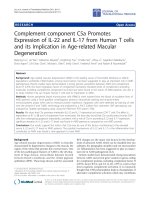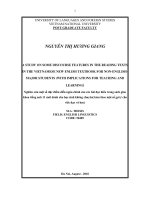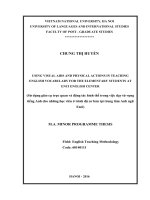ENGLISH AFFIXATION AND ITS IMPLICATION IN TEACHING VOCABULARY
Bạn đang xem bản rút gọn của tài liệu. Xem và tải ngay bản đầy đủ của tài liệu tại đây (189.48 KB, 23 trang )
VIETNAM NATIONAL UNIVERSITY, HANOI
UNIVERSITY OF LANGUAGES AND
INTERNATIONAL STUDIES
POST- GRADUATE DEPARTMENT
ENGLISH AFFIXATION AND ITS IMPLICATION
IN TEACHING VOCABULARY
SEMANTICS
( Final Assignment )
Student: Nguyễn Thị Thanh
Group: K18C
Supervisor: Dr. Hà Cẩm Tâm
HÀ NỘI –2010
Table of contents
Chapter 1: Introduction
Chapter 2: Development
2.1 Affixation definitions
2.2 A classification of English affixation
2.2.1 Suffixes
2.2.2 Prefixes
Chapter 3: Implications for teaching and learning vocabulary
Chapter 4: Conclusion
Chapter 5: References
CHAPTER 1: INTRODUCTION
1. Rationale
As English becomes the world dominant language in every aspect of social life
and Vietnam is certainly not an exception. However, the problems raised by the
complexity and diversity of the language vocabulary have driven all learners
confused and discouraged. Semantics researcher have carried out uncountable
number of studies on this matter and obtained considerable results which are
proved to be useful and practical for the learning and teaching process.
On the other hand, mastering the English vocabulary is not merely remembering
the word usage and meaning but also involves controlling its affixation which
creates new vocabulary. The solution to this will therefore benefit language
learning and teaching in many fields.
2. Aims of the study
In the first place, the study mainly focuses on the definition and classification of
the English affixation according to Ingo Plag (2002). This is followed by some
further implications for teaching and learning English as a foreign language.
3. Methods of the study
The study is conducted based mainly on the collection and selection of academic
research and literature in the same topic. Some reliable websites on the Internet
have been great helpful. Furthermore, information from the Semantics MA course
also contributes to this study
4. Design of the study
There are 5 main chapters in the research. Chapter 1 reveals the reason leading to
the study, chapter 2 develops definition and classification of the English affixation
according to Ingo Plag (2002), chapter 3 shows some implications for teaching
and learning language. Chapter 4 summarizes what has been covered in the study
and the last chapter provides the sources of information used.
CHAPTER 2: DEVELOPMENT
2.1 Affixation definition
According to Cambridge Advanced Learner’s Dictionary (second edition), affix is
a letter or group of letters which are added to the beginning or end of a word to
make a new word. Therefore, “un” and “dis” can be categorized as affixation.
Moreover, Matthews (1991) also cited that affixation is the morphological process
whereby an affix is attached to a root or stem.
However, Ingo Plag (2002) defined affix as a bound morpheme that attaches to the
base. He also pointed out that the problem of what is supposed to be the free and
bound morpheme and when something is treated as the root or the morpheme. In
such cases, he concluded, only a careful analysis of its linguistic properties can
reveal whether the element in question is really the same in both cases.
2.2 A classification of English affixation
It is obvious to admit that there are enormous ways of classifying affixation. That
can be divided into derivational, like –ness and pre, or inflectional, like plural –s
and past tense – ed.
However, for fear of complicated classification confusing low level learners, that
way of classification will not be discussed here. This study deals with the view of
Ingo Plag because of its simplicity and authenticity, which would be regarded as
learner-centered teaching methodology.
In his book “Word formation in English”, Ingo Plag divided affixation into three
sub-groups: suffixes, prefixes, and infixes. However, this study only focus on the
first two categories due to their domination and popularity in teaching and learning
the English language.
2.2.1 Suffixes
2.2.1.1 Nominal suffixes
Nominal suffixes are often employed to derive abstract nouns from verbs,
adjectives and nouns. Such abstract nouns can denote actions, results of actions, or
other related concepts , but also properties, qualities and so on. Another large
group of nominal suffixes derives person nouns of various sorts. Very often these
meaning are extended to other.
The following table is a short summary of nominal suffixes
Number
Nominal suffixes
Meaning
Example
1
- age
Activity, or its result, nouns Coverage
denoting a collective entity or Leakage
quantity, location
Acreage
Voltage
Orphanage
2
- al
Form abstract nouns denoting Arrival
an action or the result of an Recital
action
3
-ance
(-ence, Action nouns
-ancy, - ency
Renewal
Absorbance
Furtherance
Expectance
Dependence
Dependency
4
- ant
Nouns referring to person or Applicant
to
substances
biological,
involved
chemical
physical process
in Defendant
or Attractant
Dispersant
Suppressant
5
- cy / - ce
States, properties, qualities or Convergence
facts or can refer to an office Emergence
or institution
Adequacy
Intimacy
6
- dom
“the
state
of
presidency
being Apedom
something”, refer to collective Slumdom
entities, domains, realms or Clerkdom
territories
Boredom
Freedom
Studentdom
Kingdom
Cameldom
Maoridom
7
- ee
Nouns
denoting
sentient Employee
entities that are involved in an Pickpocketee
event as non – volitional Biographee
participant
Amputee
Standee
Rehabilitee
8
- eer
“person who deals in, is Auctioneer
concerned with or has to do Budgeter
with something”
Cameleer
Mountaineer
Pamphleteer
9
-er/ or
Volitional participants in an Blender
event,
instrument
nouns, Mixer
place, origin or residence
Diner
Lounger
Winner
Londoner
New Yorker
Conductor
10
- (e)ry
Locations
which
stand
in Bakery
some kind of connection to Pottery
what is denoted by the base.
Fishery
Cannery
Cakery
11
- ess
Nouns refer exclusively to Princess
female human or animals
Lionees
Hostess
Actress
Stewardess
12
- ful
waitress
Partitive nouns from nominal Bootful
base
words
that
can
construed as containers
be Handful
Cupful
Stickful
Tumblerful
basketful
13
- hood
Concepts, collectivity
Adulthood
Childhood
Farmerhood
Neighborhood
Companionhood
14
- an/ -ian/ - ean
Nouns denoting persons and Technician
places
Electrician
Musician
Bostonian
Lancastrian
Mongolian
Utopian
15
- ing
Processes
Begging
Running
Building
Sleeping
16
- ion
Events or results of processes, Colonization
are
found
primarily
scientific discourse
in Collocation
Starvation
Identification
Classification
17
- ism
Sedimentation
Forming abstract nouns from Blondism
other nouns and adjectives, Parkinsonism
denoting
concept
state, Conservatism
condition, attitude, system of Revisionism
belief or theory
Marxism
18
- ist
Person, attitudes, belief and Ballonist
theory
Careerist
Fantasist
Minimalist
19
- ity
Changing the stress pattern of Curiosity
the base
Productivity
Readability
Responsibility
Solidity
20
- ment
Action
nouns
denoting Assessment
processes or results from
Endorsement
Involvement
Treatment
Improvement
21
- ness
Can be attached to practically Thingness
any adjectives
Happiness
Over – top – ness
22
- ship
State, condition, base words Friendship
are mostly person nouns
Apprenticeship
Statesmanship
Post mastership
Censorship
2.2.1.2 Verbal suffixes
There are four suffixes which derive verbs from other categories: -ate, - en, - ify, ize
Verbal suffixes
- ate
Meaning
Example
Represent a rather large Fluorinate
heterogeneous
There
is
group. Methanate
a
class
of Regulate
derivatives with chemical Dissonate
substances
as
which
exhibit
- en
bases, Fidate
systematically Mercurate
ornative
and
resultative meanings.
Causative “make more of Blacken
something”
Broaden
Quicken
Strengthen
Lengthen
- ify
Shows the same range of Humidity
related meanings
Solidity
Nazify
Purify
- ize
Locative,
causative,
ornative, Computerize
resultative, Randomize
inchoative, performative, Cannibalize
similative
Emphasize
Feminize
2.2.1.3 Adjectival suffixes
The Adjectival suffixes can be subdivided into two major groups. A large
proportion of derived adjectives are relational adjectives, whose role is simply to
relate to nouns the adjective qualifies to the base words. The other group that
expresses more specific concepts is called qualitative adjectives.
Number Adjectival suffixes
1
-able
Meaning
Example
“capable of being Xed” and Perishable
“liable or disposed to X”
Fashionable
Reasonable
Knowledgeable
Allocable
2
- al
Attaches to almost Latin Accidental
bases
Colonial
Cultural
Federal
Modal
Institutional
3
- ary
Again a relational adjective – Complementary
forming suffix
Documentary
Fragmentary
Evolutionary
Legendary
Precautionary
4
- ed
“having X, being provided Broad- minded
with X”
Pig – headed
Wooded
Empty – headed
Short – legged
Kind – hearted
5
- esque
Convey the notion of “ in the Picturesque
manner or style of X”
Chaplinesque
Heingwayesque
Kafkaesque
6
- ful
“having
X,
being Beautiful
characterized by X”
Purposeful
Tactful
Resentful
Forgetful
7
- ic/ ical
Attaches to foreign bases
Economic
Magic
Historic
Historical
electrical
electric
8
- ing
Positions and state
Changing
Boring
Running
Waiting
Raining
9
- ish
Somewhat X, vaguely X, of Clearish
the character of X, like X ot Freeish
pejorative meaning
Soonish
Childish
Selfish
10
- ive
Forms
adjectives
mostly Connective
from Latin verbs and bound Instinctive
root
Massive
Active
Receptive
Passive
Offensive
11
- less
As antonymic to –ful, means Expressionless
“without X”
Hopeless
Careless
Thankless
Speechless
12
- ly
In the manner of X, like an X Womanly
or temporal concepts
Manly
Daily
Monthly
Fatherly
13
- ous
Derives
adjectives
from Curious
nouns and bound root, the Erroneous
vast majority being of Latin Dangerous
origin
Ambiguous
Continuous
2.2.1.4 Adverbial suffixes
Adverbial suffixes
- ly
Meaning
Example
The presence of this exclusively Shortly
de- adjectival suffix is for the Hardly
most part syntactically triggered Dryly
and obligatory, therefore it can Darkly
be considered inflectional.
Carelessly
Happily
- wise
In the manner of X, like X, Food- wise
indicates
arrangement.
movements, Like – wise
Cross – wise
Status-wise
2.2.2 Prefixes
The prefixes of English can be classified semantically into the following groups
1. ACTION
PART
MEANING EXAMPLE PART
MEANING EXAMPLE
cede/ceed (go)
proceed
rupt
(break)
erupt
cred
(believe)
credit
scrib/scrip (write)
describe
graph
(write)
autograph
sect
(cut)
bisect
ject
(throw)
eject
ven
(come)
intervene
mit/miss (send)
emit
ver
(turn)
divert
mute
(change)
commute
viv
(live)
survive
port
(carry)
deport
2. LOCATION
PART
MEANING
EXAMPLE
cir
(around)
circulate
ex
(out)
exit
in
(in)
include
re
(back)
return
sub
(under)
subway
tele
(far)
telephone
trans
(across)
transatlantic
3. UNIVERSE
PART
MEANING
EXAMPLE
geo
(earth)
geology
terr
(earth)
territory
hydr
(water)
hydroplane
aqua
(water)
aquatic
astr
(star)
astronaut
pyr
(fire)
pyrotechnics
PART
MEANING
EXAMPLE
corp
(body)
corporation
card
(heart)
cardiology
derm
(skin)
dermatologist
man
(hand)
manual
dent
(teeth)
dentist
ped/pod
(feet)
pedestrian
cap
(head)
captain
4. BODY
5. HUMAN STATES
PART
MEANING EXAMPLE PART
MEANING EXAMPLE
am
(love)
amiable
(feeling)
sympathy
phil
(love)
Philadelphia mania
(crazy)
maniac
bene
(good)
benefit
(fear)
claustrophobia
eu
(good)
euphemism psycho
(mind)
psychology
mal
(bad)
malcontent bio
(life)
biology
dys
(bad)
dysfunction mor
(death)
mortal
path
phobia
6. PEOPLE
PART
MEANING
EXAMPLE
pater
(father)
patriarch
mater
(mother)
maternity
frater
(brother)
fraternal
domin
(master)
domination
jud
(judge)
judgment
anthro
(people)
anthropology
demo
(people)
democracy
7. SENSES
PART
MEANING
EXAMPLE
spec
(see)
spectator
vis/vid
(see)
visit/ video
scope
(see)
telescope
phon
(hear)
telephone
aud
(hear)
audience
dic
(say)
dictate
loc/loq
(speak)
eloquent
CHAPTER 3: IMPLICATIONS FOR TEACHING AND LEARNING
VOCABULARY
In the author’s point of view, the implications of English affixation can be applied
in every aspect of teaching and learning the language. However, due to the highly
– recommended practicability and usefulness of this issue, it is suggested that
implications for teaching and learning vocabulary would be of greater necessity
than reading, speaking, listening and writing skills.
That is the reason why this study will mainly focus on teaching and learning
vocabulary. Further study about English affixation in teaching other skills can be
conducted in the future.
Controlling the vocabulary will be much efficient if teacher pay attention to equip
learners with at least some basic concepts about affixation.
The table of suffixes and prefixes were designed in a learner friendly way, so that
not only teachers but also students will find it easy to follow and understand. Once
given the basic knowledge about common suffixes and prefixes, there can be no
considerable difficulty for learners to remember the meaning of long and complex
words.
Examples of some techniques to teach student about English affixation will be
discussed in the following analysis.
3.1 Using pictures and maps
SPECTATOR (spec = see)
CAPTAIN (cap = head)
DENTIST
TELEPHONE
(dent = tooth)
(tele = far; phone = speak)
3.2 Using games
Game 1: Guessing word meaning through multiple choice question
1. What is the meaning of dermatologist
A. a scientist deals with biology
B. a doctor who specializes in the treatment of diseases of the skin.
C. a theory of dental
D. none of the above
The correct answer is B, student will be able to answer this question if they have
already known that derma = related to skin and ist = person doing the action.
2. Which word can complete the following sentence?
The … told every sailors what to do in the terrible storm.
A. Dentist
B. Pedestrian
C. Captain
D. Dermatologist
If learners know that
-
dent = tooth
-
ped = foot
-
cap = head, leading
-
derm = skin
there will be no difficult for them to choose the right answer C in this question.
Game 2: Find out the correct affixation
Teacher may create matching, filling the blank or correcting the wrong affixation
in this kind of game.
• Matching the suitable affixation
Prefixes
Roots
Suffixes
In
Dispens
O
Dis
Tain
Able
Cap
Advantage
Able
Fore
See
ous
• Filling the blank
1. ….ctator :see
2. …sit/ ….eo : see
3. ….scope: far
4. tele….: speak
5. …ience: hear
6. ….tate: write
7. e….uent: speak
• Correcting the wrong affixation
1. Electricist (electrician)
2. scienter (scientist)
3. independition (independence)
4. collocatance (collocation)
These are just a few techniques that can be of great help in teaching the language
vocabulary. Student will find out that remembering the meaning of affixation can
help them a lot in mastering a considerable number of new concepts.
CHAPTER 4: CONCLUSION
English affixation is one of the most fascinating but confusing part of English.
Whenever the students of English are aware of this matter they will not regard it as
difficulty they have to face with. That is also the reason why I am so concerned
about English affixation and its usefulness.
On the other hand, I believe that further implications of teaching and learning
English affixation can be later studied in the field of teaching reading, listening,
speaking and writing skills. That may be the interest for future research and
studies.
In conclusion, although I have tried to cover every aspect of English affixation,
there are still limits and drawback in my study. Thus, all comments and feedbacks
about my study will be highly appreciated.
CHAPTER 5: REFERENCES
1. Ingo Plag, 2002, Word – formation in English, Cambridge University
Press
2. Cambridge Advanced Learner’s Dictionary, second edition
3. Adams, Valerie 2001, Complex Words in English, Harlow: Longman
4. Bauer, Laurie 1998b, “When is a sequence of two nouns and is it
productive?”, Linguistics 36: 403 -422
5. Booji, Geert E. 1977, Dutch Morphology: A Study of Word
Formation in Generative Grammar, Lisse: de Ridder.









